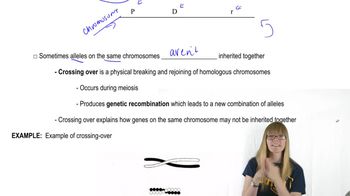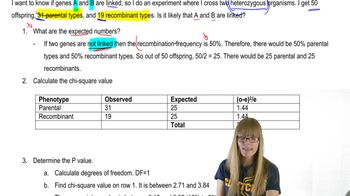True or False:Recombination frequencies are never greater than 50%
Table of contents
- 1. Introduction to Genetics51m
- 2. Mendel's Laws of Inheritance3h 37m
- 3. Extensions to Mendelian Inheritance2h 41m
- 4. Genetic Mapping and Linkage2h 28m
- 5. Genetics of Bacteria and Viruses1h 21m
- 6. Chromosomal Variation1h 48m
- 7. DNA and Chromosome Structure56m
- 8. DNA Replication1h 10m
- 9. Mitosis and Meiosis1h 34m
- 10. Transcription1h 0m
- 11. Translation58m
- 12. Gene Regulation in Prokaryotes1h 19m
- 13. Gene Regulation in Eukaryotes44m
- 14. Genetic Control of Development44m
- 15. Genomes and Genomics1h 50m
- 16. Transposable Elements47m
- 17. Mutation, Repair, and Recombination1h 6m
- 18. Molecular Genetic Tools19m
- 19. Cancer Genetics29m
- 20. Quantitative Genetics1h 26m
- 21. Population Genetics50m
- 22. Evolutionary Genetics29m
4. Genetic Mapping and Linkage
Mapping Genes
Problem 8a
Textbook Question
Gene G recombines with gene T at a frequency of 7%, and gene G recombines with gene R at a frequency of 4%.
Draw two possible genetic maps for these three genes, and identify the recombination frequencies predicted for each map.
 Verified step by step guidance
Verified step by step guidance1
Understand that recombination frequency is proportional to the physical distance between genes on a chromosome. A 7% recombination frequency between genes G and T means they are 7 map units apart, and a 4% recombination frequency between genes G and R means they are 4 map units apart.
Consider the possible arrangements of the three genes (G, T, and R) on the chromosome. Since G is the reference point, the two possible arrangements are: (1) G is between T and R, or (2) T and R are on the same side of G.
For the first arrangement (G between T and R), place G in the middle, with T 7 map units away from G and R 4 map units away from G. Calculate the predicted recombination frequency between T and R by summing the distances between T and G and G and R.
For the second arrangement (T and R on the same side of G), place G at one end, with T 7 map units away from G and R 4 map units away from G. Calculate the predicted recombination frequency between T and R by subtracting the smaller distance (4 map units) from the larger distance (7 map units).
Compare the predicted recombination frequencies for T and R in both arrangements. These frequencies will help determine which genetic map is more likely based on experimental data.
 Verified video answer for a similar problem:
Verified video answer for a similar problem:This video solution was recommended by our tutors as helpful for the problem above
Video duration:
1mPlay a video:
Was this helpful?
Key Concepts
Here are the essential concepts you must grasp in order to answer the question correctly.
Recombination Frequency
Recombination frequency is a measure of the likelihood that two genes will be separated during meiosis due to crossing over. It is expressed as a percentage, indicating the proportion of offspring that exhibit a recombinant phenotype. A higher recombination frequency suggests that genes are located further apart on a chromosome, while a lower frequency indicates they are closer together.
Recommended video:
Guided course

Recombination after Single Strand Breaks
Genetic Mapping
Genetic mapping is the process of determining the relative positions of genes on a chromosome. This is achieved by analyzing recombination frequencies between pairs of genes. By constructing genetic maps, researchers can visualize the arrangement of genes and predict the likelihood of recombination events, which is essential for understanding inheritance patterns.
Recommended video:
Guided course

Mapping Overview
Linkage and Linkage Disequilibrium
Linkage refers to the tendency of genes located close to each other on a chromosome to be inherited together during meiosis. Linkage disequilibrium occurs when the association between alleles at different loci is non-random, often due to physical proximity. Understanding linkage is crucial for interpreting recombination frequencies and constructing accurate genetic maps.
Recommended video:
Guided course

Chi Square and Linkage
Related Videos
Related Practice
Multiple Choice
606
views
3
rank


